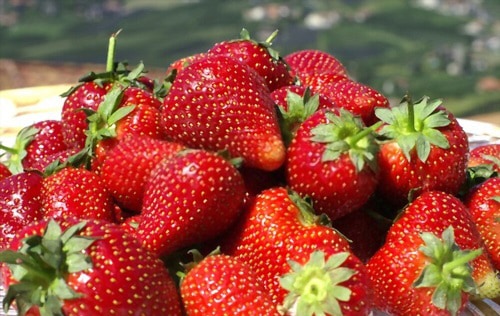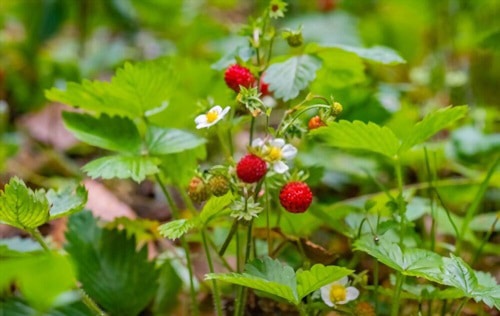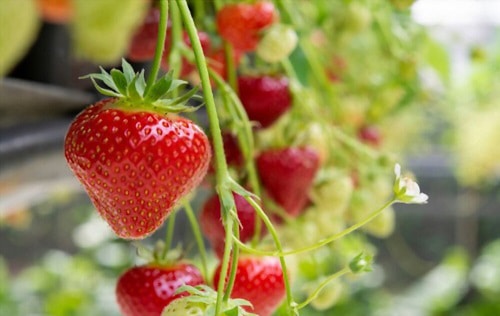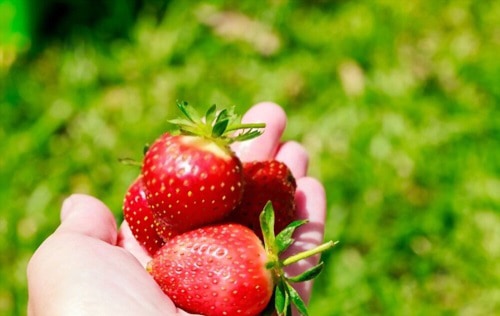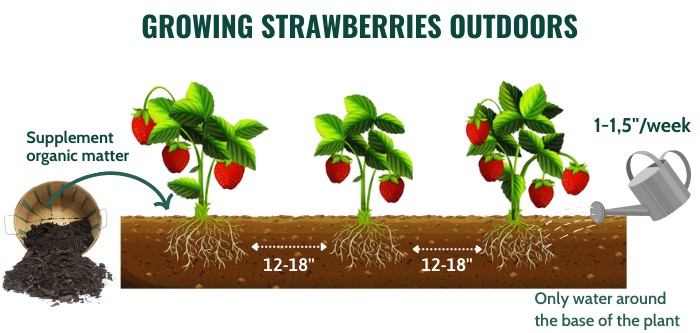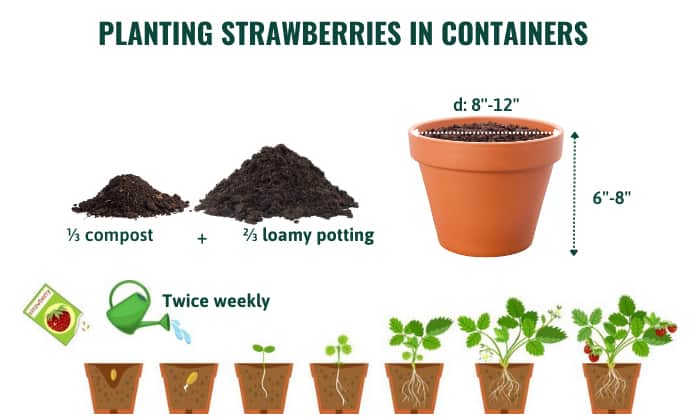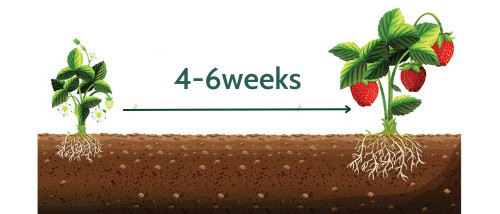Strawberries are fairly easy to grow and are productive when it comes to fruiting. They are temperate crops, so if you’re from warmer climates such as zone 8, you should definitely know when to plant them first.
So, when to plant strawberries in Zone 8? They are planted in fall or spring—from March 27 to April 11 when planted directly outdoors or January 17 to 31 when grown indoors. August 9-30 is another time for planting if you garden in autumn.
Want to know more? Simply read further this article!
Table of Contents
Best Time to Plant Strawberries in Zone 8
1. Planting directly outdoors
You can grow strawberries in the spring 2 weeks after the dangers of frost no longer threaten your garden, from March 27 to April 11 both for zone 8A and zone 8B. This is also a good time to plant bare root strawberries.
Mid to late fall planting is also possible if you grow strawberries from August 9 to August 30, as long as the fruits are able to mature within 90 days before the first fall frost.
2. Starting strawberries indoors
If you want to plant strawberries indoors in containers, late winter is the most recommended time to do so. Begin growing them from January 17 to February 1, then transplant outdoors based on the direct planting dates mentioned above.
Strawberry Growing Zone
Below is a map depicting the various strawberry zone in the country. As you can see, strawberries can be planted in Zones 2 to 10.
As such, growing strawberries depends on the extreme minimum temperatures of your area. For example, compared to zone 8A strawberries in Georgia, late fall to early spring (November to April) is the recommended time to plant strawberries in zone 7.
Best Varieties of Strawberries for Zone 8
Refer to the table below for the various types of strawberries you can grow in Zone 8 and their characteristics:
1. Earliglow
- Type: June-bearing strawberries
- ruit Size: Medium
- Yield: Heavy
- When to Plant: Spring to early fall when soil temperatures range from 60°F to 80°F
2. Camino Real
- Type: June-bearing strawberries
- Fruit Size: Small
- Yield: Light
- When to Plant: Either early to mid spring or early to mid fall when temperatures are 60°F
3. Albion
- Type: Everbearing strawberries
- Fruit Size: Large
- Yield: Heavy
- When to Plant: Best grown in late spring to fall when soil temperatures reach 60°F
4. Monterrey
- Type: Everbearing strawberries
- Fruit Size: Large
- Yield: Moderate
- When to Plant: Mid to late spring when temperatures are consistently 60°F
5. Tristar
- Type: Day-neutral strawberries
- Fruit Size: Medium
- Yield: Light to heavy
- When to Plant: Early spring at optimum soil temperatures between 60°F to 80°F
6. Seascape
- Type: Day-neutral strawberries
- Fruit Size: Large
- Yield: High
- When to Plant: Early spring when temperatures are between 60°F to 80°F
Strawberry Planting Calendar
Here’s a quick summary of growing strawberries in Zone 8:
| Month | Task |
| March | If you used straw mulch to protect strawberries against winter cold, remove most of it when strawberries begin to grow leaves. |
| March and April | Plant strawberries outdoors. |
| April | Remove flowers from the plants by pinching them. This encourages energy to flow into the shoot and stimulate root growth. |
| June | Thin blossoms of June-bearing strawberries during the first year so that there are more runners and larger fruits next season. |
| June to July | Amend soil of day-neutral strawberries with compost containing nitrogen if they’re not growing well. |
| June to September | Remove strawberry runners or stolons of June-bearing strawberries to produce bigger fruits |
| October | When you overwinter strawberries, use mulch such as wood shavings, pine needles, or straw to cover the plants. |
Growing Strawberries Outdoors
- Perform a soil test prior to planting. Supplement any nutrients your soil lacks and add organic matter such as aged compost.
- Space your strawberry plants 12 to 18 inches apart, since they are a sprawling species, which means their seedlings will develop runners that also produce subsequent runners.
- Insert your transplants at a sufficient depth—the center of the crown should be level with the soil surface and the roots should be completely covered with soil. Afterwards, pat the soil around the transplant to make it evenly firm.
- Water thoroughly and provide 1 to 1 ½ inches of water every week. Only water around the base of the plant to avoid getting the foliage wet.
- You may apply a continuous-release fertilizer, compost, or organic-type fertilizers with nitrogen to aid in plant growth.
Planting Strawberries in Containers
- Select a container that is 8 to 12 inches in diameter and 6 to 8 inches in depth. You can also choose similarly-sized hanging baskets, planters, and window boxes as long as they have drainage holes.
- Pour a soil mix into your chosen containers. A ratio of ⅓ compost and aged manure and ⅔ loamy potting mix is the most recommended strawberry soil mix.
- When inserting transplants, make sure their crowns are directly above the soil line and the roots are fully buried in the soil mix.
- Afterwards, thoroughly water the plant twice weekly. The soil should be consistently moist but not to the point of sogginess.
- Lastly, apply a balanced liquid fertilizer every 3 to 4 weeks.
Strawberry Harvesting Guide
Generally, the harvesting period begins 4 to 6 weeks after fruits have blossomed and may last up to 3 weeks. However, this depends on the maturity time and yield of the strawberry variety.
To harvest, simply perform the following steps:
- Start picking strawberries in the morning when they are still cool.
- From the vine of the fruits, twist the stem of each berry and gently pull them off or you can cut the stem directly to reduce the risk of damaging the berry.
- Repeat the process every 3 days, but if you are experiencing hot temperatures in your area, harvest daily or every other day.
Remember to pick berries that are fully ripe, which means they must completely be red in color. Those that still have white portions on them should be left on the vine.
Tips for Keeping Strawberries Healthy
1. Site and Soil
When planting outdoors, choose a sunny spot in your garden where strawberries can receive full sun exposure. Shade-planted strawberries will not be as productive when it comes to yields.
You can also place container-planted strawberries in a south-facing window, allowing them to absorb as much sunlight as possible.
Strawberries prefer sandy or loamy soil that is organically-rich, well-draining, gradually-sloping, and has a pH level between 5.8 and 6.2. Soil testing is essential so that you can apply whatever nutrients your soil lacks and adjust its acidity.
2. Water
The plants must be given readily available water, especially during periods of drought or intense heat. 1 to 2 inches of regular weekly watering is the most recommended to make sure that the berries reach optimal growth.
3. Weed Control
Weeds should consistently be controlled when growing strawberries as the latter won’t be able to out-compete them. Cultivation by hand-weeding or hoeing will lengthen the lifespan of your strawberry gardens.
4. Mulch
Applying a 3 to 6-inch deep mulch layer is recommended to provide strawberry plants protection against extremely cold temperatures which may injure roots. This should be done in mid-October and raked off in mid-March.
Straw is the most popular type but wood shavings, pine needles, and other organic matter that is loose can also work.
Frequently Asked Questions
How late in fall can you plant strawberries?
August 30 is the latest date that you can grow strawberries in the fall in Zone 8. However, this is an estimate based on the average first fall frost of your area and a variety that grows in 90 days.
If we use 60 days as the maturation period, September 29 would be the latest planting date.
What is the lowest temperature strawberry plants tolerate?
They can tolerate temperatures as low as 20°F to 30°F. Temperatures below this range will damage the plant’s buds and blossoms as well as lessen yields.
Are strawberries perennials or annuals?
Strawberries are planted as short-term perennials in Zones 3 to 8 and are considered annuals in zone 9 and 10.
Conclusion
Hopefully, by now you already know when to plant strawberries in zone 8. Here’s a quick recap: growing strawberries in this region depends on your chosen location (indoors or outdoors), temperature, and season.
Just make sure you’re planting at optimal soil temperatures of 60°F to 80°F and that you follow the tips and tricks in taking care of and maintaining strawberries. With this, you can expect bountiful, lush red berries by harvesting time!
Other vegetable planting schedules in Zone 8:

Hi, I am William – Floridayards’ digital content creator. My job is to find answers to all your concerns with thorough research and our team’s expert advice. I will also bring you honest reviews on the best products and equipment for raising your beautiful garden. Please look forward to our work!






